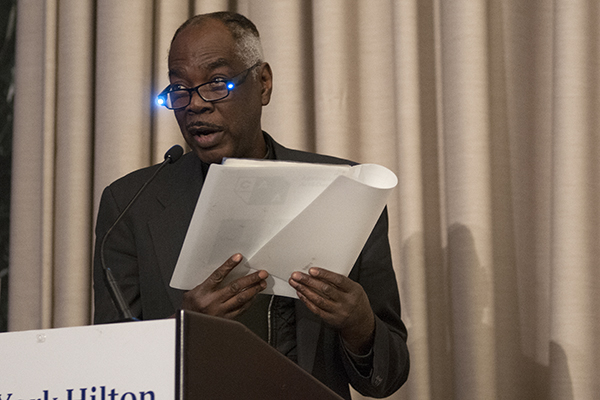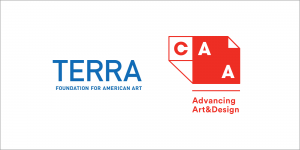CAA News Today
Announcing the 2020 CAA-Getty International Program Participants
posted by CAA — Oct 07, 2019
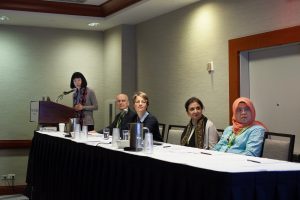
CAA-Getty International Program Participating Alumni (left to right) Chen Liu, Nazar Kozak, Katarzyna Cytlak, Nadhra Khan, and Sarena Abdullah at the 2019 Annual Conference in New York. Photo: Ben Fractenberg
We’re pleased to announce this year’s participants in the CAA-Getty International Program. Now in its ninth year, this international program supported by the Getty Foundation will bring fifteen new participants and five alumni to the 2020 Annual Conference in Chicago, Illinois.
The participants—professors of art history, curators, and artists who teach art history—hail from countries throughout the world, expanding CAA’s growing international membership and contributing to an increasingly diverse community of scholars and ideas. This year we are adding participants from four countries not included previously—Bolivia, Saudi Arabia, Côte d’Ivoire, and Singapore—bringing the total number of countries represented by the program to fifty. Selected by a jury of CAA members from a highly competitive group of applicants, the participants will receive funding for travel expenses, hotel accommodations, conference registration, CAA membership, and per diems for out-of-pocket expenditures.
At a one-day preconference colloquium, to be held this year at the School of the Art Institute of Chicago, the fifteen new participants will discuss key issues in the international study of art history together with five CAA-Getty alumni and several CAA members from the United States, who also will serve as hosts throughout the conference. The preconference program will delve deeper into subjects discussed during last year’s program, including such topics as postcolonial and Eurocentric legacies, interdisciplinary and transnational methodologies, and the intersection of politics and art history.
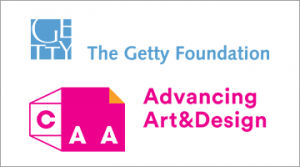
This is the third year that the program includes five alumni, who provide an intellectual link between previous convenings of the international program and this year’s events. They also serve as liaisons between CAA and the growing community of CAA-Getty alumni. In addition to serving as moderators for the preconference colloquium, the five alumni will present a new Global Conversation during the 2020 conference titled Things Aren’t Always as they Seem: Art History and the Politics of Vision.
The goal of the CAA-Getty International Program is to increase international participation in the organization’s activities, thereby expanding international networks and the exchange of ideas both during and after the conference. CAA currently includes members from sixty countries around the world. We look forward to welcoming the following participants at the next Annual Conference in Chicago.
2020 Participants in the CAA-Getty International Program
Irene Bronner, Senior Lecturer, NRF South African Research Chair in South African Art and Visual Culture, University of Johannesburg, South Africa
Eiman Elgibreen, Assistant Professor of Art History, The Princess Nourah bint Abdulrahman University, Riyadh, Saudi Arabia
Daria Jaremtchuk, Associate Professor of Art History, University of São Paulo, Brazil
Ganiyu Jimoh, Lecturer, University of Lagos, Nigeria, and Postdoctoral Fellow, Arts of Africa and Global Souths research program, Department of Fine Art, Rhodes University, South Africa
Mariana Levytska, Research Associate, Department of Art Studies, Ethnology Institute, UNAS (National Academy of Sciences of Ukraine)
Daniela Lucena, Head of Research Team, National Scientific and Technical Research Council (CONICET), University of Buenos Aires, Argentina
Ali Mahfouz, Director, Mansoura Storage Museum, Ministry of Egyptian Antiquities, Egypt
Priya Maholay-Jaradi, Convenor, Art History, National University of Singapore
Valeria Maria Paz Moscoso, Academic Coordinator and Advisor, Universidad Catolica Boliviana San Pablo, La Paz, Bolivia
Daria Panaiotti, Curator of Photography and Research Associate, The State Hermitage Museum, St. Petersburg, Russia
Aleksandra Paradowska, Assistant Professor, University of Fine Arts, Poznań, Poland
Saurabh Tewari, Assistant Professor, School of Planning and Architecture, Bhopal, India
Giuliana Vidarte, Chief Curator and Head of Exhibitions, Museum of Contemporary Art of Lima and Peruvian University of Applied Sciences, Peru
Julia Waite, Curator of New Zealand Art, Auckland Art Gallery Toi o Tāmaki, New Zealand
Jean-Arsène Yao, University Félix Houphouët-Boigny, Côte d’Ivoire
Participating Alumni
Abiodun Akande, Senior Lecturer, University of Lagos, Nigeria
Pedith Chan, Assistant Professor of Cultural Management, Chinese University of Hong Kong
Iro Katsaridou, Curator of Modern and Contemporary Art, Museum of Byzantine Culture, Thessaloniki, Greece
Cristian Emil Nae, Associate Professor, George Enescu National University of Arts, Iasi, Romania
Nora Veszpremi, Research Associate, Continuity/Rupture: Art and Architecture in Central Europe 1918–1939 (CRAACE), Masaryk University in Brno, Czech Republic
Registration Now Open for the 2020 CAA Annual Conference
posted by CAA — Oct 01, 2019
2020 CAA ANNUAL CONFERENCE
Hilton Chicago
FEBRUARY 12-15, 2020
Four days for everyone in the arts with over 300 sessions and panels, dozens of receptions and parties, professional development workshops, lightning talks, and exhibitors. #CAA2020
For the first time since 2014, the CAA Annual Conference returns to Chicago in February. We welcome all those in the visual arts to attend over 300 sessions and professional development workshops, as well as dozens of receptions, parties, and special tours at local museums and cultural institutions. The Book and Trade Fair, with over one hundred booths showcasing the latest products, programs, and books, will be on the lower level of the Hilton Chicago. Our partners offering free or discounted admission and special tours this year include Art Institute of Chicago, the Field Museum, the Design Museum of Chicago, and many others.
The 108th CAA Annual Conference content will address the full breadth of the field of visual arts and design and will examine a range of cultures, histories, and scholarship. We anticipate more than 5,000 professionals in the arts to attend the conference in Chicago. In collaboration with the Committee on Women in the Arts, we offer 50 percent of the conference’s content in celebration of the Centennial of Women’s Suffrage in the United States, while also acknowledging the discriminatory practices that limited voting rights for Indigenous women and women of color, even after the passage of the 19th amendment in 1920.
We are excited to announce that several renowned artists, designers, and scholars will be speaking at the conference. On Wednesday, February 12, Chicago-based visual artist Amanda Williams will be delivering the keynote address at Convocation. On Friday, February 14, our Artist Interviews will feature Sheila Pepe and Arnold J. Kemp, and this year’s Distinguished Scholar Session, held on February 13, will honor Kellie Jones.
Learn More about our Notable Speakers
Once again, CAA will offer travel grants and scholarships to individuals looking to attend the Annual Conference. With the generous support of Blick Art Materials and Routledge, Taylor & Francis, CAA will provide eight student member registrants with $250 each to attend the conference.
We look forward to seeing you in Chicago!
Please contact Member Services at membership@collegeart.org or at 212-691-1051, ext. 1 with any questions.
Announcing Research Travel Grants Funded by the Terra Foundation for American Art
posted by CAA — Sep 26, 2019
We’re pleased to announce our administration of the Terra Foundation for American Art Research Travel Grants.
Now administered and juried by CAA, the Terra Foundation initiated this grant program in 2003 to fund European candidates. It was expanded to reach candidates worldwide in 2012, and opened to US-based researchers in 2017 to travel abroad, developing American art scholar networks around the world with a total of 173 grantees since its inception.
The Research Travel Grants will be awarded annually, providing support to doctoral, postdoctoral, and senior scholars from both the US and outside the US for research topics dedicated to the art and visual culture of the United States prior to 1980.
“We are excited to expand our partnership with the Terra Foundation to provide continued support for scholars of American art,” said David Raizman, interim executive director of CAA. “Research funding for domestic and international scholars is essential to the vitality of the field, and these generous grants from the Terra Foundation will facilitate the advancement of their work. The inclusion of international scholars for these grants is especially gratifying, as it promotes new perspectives and engages the wider scholarly community.”
The grants foster firsthand engagement with American artworks and art-historical resources; build networks for non-US-based scholars studying American art; and expand access to artworks, scholarly materials, and communities for US-based scholars studying American art in an international context.
Awards of up to $9,000 will be granted on a per project basis by a jury formed by CAA. The first awards will be announced in March of 2020.
CAA’s administration of the Terra Foundation for American Art Research Travel Grants continues a long history at CAA of supporting travel and scholarship for professionals and students in the visual arts and design. Other grants offered by CAA include the Professional Development Fellowships for Graduate Students, the Terra Foundation for American Art International Publication Grant, the Wyeth Foundation for American Art Publication Grant, the Millard Meiss Publication Fund, the CAA Getty International Program, Travel Grants to the CAA Annual Conference, and introduced last year, the Art History Fund for Travel to Special Exhibitions.
ABOUT THE TERRA FOUNDATION FOR AMERICAN ART
The Terra Foundation for American Art is dedicated to fostering exploration, understanding, and enjoyment of the visual arts of the United States for national and international audiences. Recognizing the importance of experiencing original works of art, the foundation provides opportunities for interaction and study, beginning with the presentation and growth of its own art collection in Chicago. To further cross-cultural dialogue on American art, the foundation supports and collaborates on innovative exhibitions, research, and educational programs. Implicit in such activities is the belief that art has the potential to both distinguish cultures and unite them.
News from the Art and Academic Worlds
posted by CAA — Sep 25, 2019

Installation view of Women Take the Floor at the MFA Boston, an effort to dedicate more space to women’s artworks. Only 4 percent of the art acquired by the museum between 2008 to 2018 was by women—3,788 of 90,215 works. Image: Museum of Fine Arts, Boston, via New York Times
Female Artists Made Little Progress in Museums Since 2008, Survey Finds
New data shows that in the last ten years, only 11% of all work acquired by top US museums was by women. (New York Times)
The Getty Trust Will Spend $100 Million to Protect Archaeological Sites Around the World From Climate Change and Sectarian Violence
The organization’s ambitious new initiative includes conservation efforts, scholarship programs, publications, and exhibitions. (artnet News)
‘It’s About Time!’ Betye Saar’s Long Climb to the Summit
The artist’s solo exhibition at MoMA will debut with the reopening of the newly expanded museum on October 21. (New York Times)
How Much Does an Adjunct Actually Make?
“What if everyone just told their students how much they got paid?” According to a 2015 study, one in five part-time faculty members live below the federal poverty line. (Hyperallergic)
Want articles like these in your inbox? Sign up:
CWA Picks for September 2019
posted by CAA — Sep 12, 2019
CAA’s Committee on Women in the Arts selects the best in feminist art and scholarship to share with CAA members on a monthly basis. See the picks for September below.
FAST FASHION/SLOW ART
Luther W. Brady Art Gallery, The George Washington University, Washington, DC
August 9 – December 15, 2019
Beyond the glitz and glamour of the fashion industry are serious timely questions around waste and consumerism in the garment industry, which is what the contemporary artists and filmmakers explore in Fast Fashion/Slow Art. The diverse group of emerging and established contemporary artists and filmmakers from China, Denmark, Germany, Norway, and the United States includes Julia Brown, Carole Frances Lung (Frau Fiber), Cat Mazza, Senga Nengudi, Martha Rosler, Hito Steyerl, Martin de Thurah, Rosemarie Trockel, and Wang Bing, who collectively encourage scrutiny of today’s garment industry. For example, Bing’s documentary installation, 15 hours, was shot in a factory in China, capturing the labor of some of its 300,000 workers, emitting a meditation on the contemporary meaning of work in present-day China. Also available during the exhibition are two web programs, ”Planet Money Makes a T-Shirt” and “Sweatshop—Deadly Fashion.”
Her Own Way
Female Artists and the Moving Image in Art in Poland: From 1970s to the Present
Tokyo Photographic Art Museum
August 14 – October 14, 2019
The exhibition of artworks by Polish women artists features moving image, which has a rich history in Polish art scene. Women artists have used video and photography even though during the Cold War those working “behind” the Iron Curtain had little access to equipment and training. Despite hardships, women experimented with video expression. Following democratization of the country after the fall of the Berlin Wall and the introduction of the free market economy, Poland welcomed economic growth and material affluence. This contributed to deepening income gaps and rapid changes in value. Polish critical art of the 1990s addressed those contradictions in society. Those who were born under the Communist regime and brought up after democratization started looked back with a critical distance to explore new perspectives and question complex social and political conditions. This has driven a rich and diverse landscape for moving image, including the use of more accessible media. The exhibition features works from 1970s onwards questioning contradictions of the global economic system. It includes some of the key figures in Polish art scene including Bogna Burska, Izabella Gustowska, Zuzanna Janin, Katarzyna Kozyra, Anna Kutera, Natalia LL, Ewa Partum, Agnieszka Polska, Joanna Rajkowska, and Alicja Rogalska, among others.
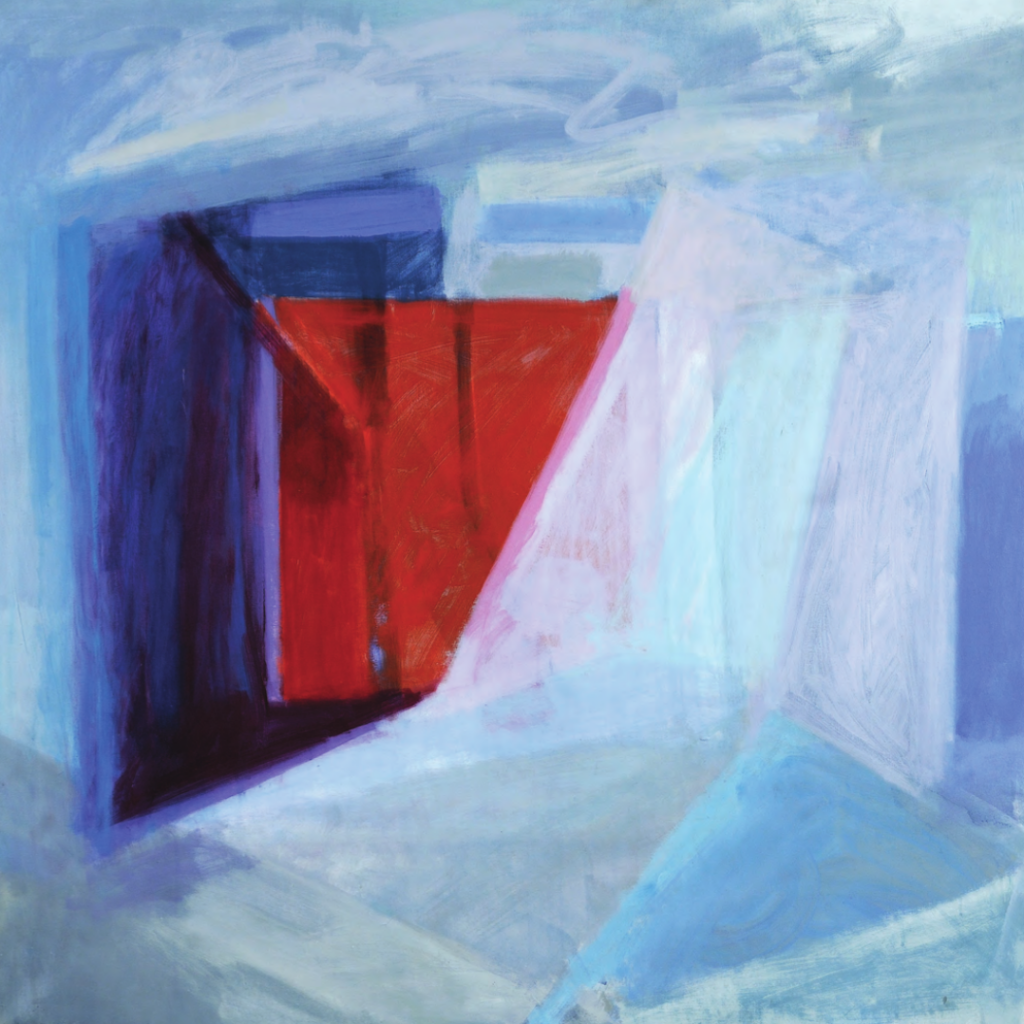
Helene Herzbrun, Entrances (detail), 1977. Acrylic on canvas, framed: 52 5/8 × 52 3/4 × 1 5/8 in., image: 52 × 52 in. American University Museum, X1639.
Grace Hartigan & Helene Herzbrun: Reframing Abstract Expressionism
American University Museum at the Katzen Arts Center, Washington, DC
September 3 – October 20, 2019
The past few years has witnessed an urgent reappraisal of the Abstract Expressionist canon in the United States. Recent game-changers, such as the Women of Abstract Expressionism exhibition and catalogue (2016), and steady growth in the art market, have turned a sharp eye on the women whose careers received little critical and financial support during and after the heyday of heroic gesturalism and figurative abstraction in the 1950s. Norma Broude, the distinguished feminist art historian and professor emerita at The American University, has organized an exhibition that argues for a reframing of the geographic center of New York, and presents a two-person show on Grace Hartigan (1922-2008) and Helene Herzbrun (1922-1984). Both artists, who had a cordial friendship, had lived and exhibited for many decades around the Baltimore and Washington, DC region, and many of the paintings on view are drawn from local private collections and museums. Hartigan, the more celebrated of the two, has received considerable scholarly attention. Her early career in New York was shaped by social relationships with the first generation of Abstract Expressionists, including Jackson Pollock and Willem de Kooning (a seminal influence), and the seductive riffraff of modern life in the fifties around her studio on the Lower East Side. Hartigan often incorporated the popular and material subjects—the “vulgar and vital”—from her surroundings, and Baltimore eventually proved to have much to offer. Her early artistic development was also largely influenced by her own study of paintings at the Metropolitan Museum of Art and transformative friendships with poets Frank O’Hara and Barbara Guest. By 1953, she had the attention of Alfred Barr, Jr. and curator Dorothy C. Miller, who accessioned her Baroque-inspired masterpiece, Persian Jacket (1952), into the permanent collection of the Museum of Modern Art; this was followed by her participation as the only woman artist in MoMA’s groundbreaking exhibitions, 12 Americans (1956) and The New American Painting (1958-1959). Broude’s catalogue essays purposefully consider the negative impact on Hartigan’s career after leaving New York City for Baltimore, and the artist’s serious disappointment in the regional artistic scene. This shifted to some degree when she found support in her new intellectual community as a revered professor and mentor at the Maryland Institute of Art (MICA), Hoffberger School. Comparably, Broude develops a fascinating biographical sketch of Helene Herzbrun, whose archives are held at American University. Herzbrun experienced similar challenges in her desire to establish critical recognition outside the parameters of New York and beyond the stylistic popularity of Color Field painting practiced by her male contemporaries in Washington. Herzbrun maintained an important correspondence with Ab-Ex artist Jack Tworkov, with whom she worked as a MFA student at AU. She was a faculty member in the University’s art department until her death in 1984. Addressing the limited opportunities for artists in the area, Herzbrun co-founded an important cooperative space called Jefferson Place Gallery in DC. Hartigan and Herzbrun make exciting visual partners in Reframing Abstract Expressionism. Their painterly dialogues on nature and the landscape interrogate the creative process and explore the persistent motivations to paint abstractly while negotiating representation, structure, and spontaneity, all essential components of the living language of Abstract Expressionism. This exhibition expands our understanding of the networks of production and distribution of ideas and resources on Abstract Expressionism to the regional centers of the country.
Affiliated Society News for September 2019
posted by CAA — Sep 11, 2019
Affiliated Society News shares the new and exciting things CAA’s affiliated organizations are working on including activities, awards, publications, conferences, and exhibitions.
Interested in becoming an Affiliated Society? Learn more here.
SECAC
The 75th Annual SECAC Conference, hosted by the University of Tennessee at Chattanooga, will be held October 16 through 19, 2019. More than 540 papers—on studio art, art history, art education, and graphic design—will be presented in 142 sessions. All sessions will take place at the Chattanoogan Hotel. Offsite events include the annual SECAC Artist’s Fellowship and Juried Exhibitions and a keynote address by artist, educator, and advocate for artists, Sharon M. Louden, who serves as editor of the Living and Sustaining a Creative Life series of books and Artistic Director of the Visual Arts at Chautauqua Institution. More information and conference registration are available at https://secacart.org/page/Chattanooga.
Society for the Study of Early Modern Women and Gender (SSEMWG)
Foundation for Advancement in Conservation
Material Immaterial: Photographs in the 21st Century Symposium and Seminars
September 23-25, 2019, Yale University, New Haven, CT
Organized by Paul Messier and Monica Bravo
We are witnessing the historic transformation of photography from tangible objects—prints, plates, and negatives—to code: intangible bits, bytes, and pixels. As the tether between visual culture and the material world is recalibrated every day, a new form of literacy is required to draw meaning from physical media and its obsolescence. At the very moment when characterization and interpretation of the printed photograph is rapidly gaining ground, the momentum toward dematerialization raises the issue of the long-term relevance and sustainability of photography as a material fact. Does the physical photograph still matter today—as a source for teaching, learning, and scholarship—and will it matter into the future?
This symposium and elective seminars will provide insight into new tools for researching photographs with an emphasis on both the material and immaterial aspects of the medium. Conservation professionals will gain practical knowledge on new and existing techniques for characterizing prints and collections and how this information can be structured and visualized. Curators and art historians will benefit from exposure to the methods and techniques that underlie the contemporary approaches to material history. Together, the presentations and discussions are meant to demystify techniques adapted from seemingly exotic fields of artificial intelligence and data science and to cover some basic techniques for understanding and interpreting the physical and chemical makeup of a photographic print.
View the program for detailed a schedule and speaker list or visit the event website to register.
Support for this program comes from The Andrew W. Mellon Foundation Fund for Collaborative Workshops in Photograph Conservation, a grant from the National Endowment for the Humanities, and the Foundation for Advancement in Conservation Endowment for Professional Development.
Association for Modern and Contemporary Art of the Arab World, Iran, and Turkey (AMCA)
“AMCA Interview with the Winner of the 2019 Rhonda A. Saad Prize for Best Paper in Modern and Contemporary Arab Art”
The 2019 Rhonda A. Saad Prize for Best Paper in Modern and Contemporary Arab Art was awarded to Lara Ayad for her paper “Homegrown Heroes: Peasant Masculinity and Nation-Building in the Paintings of Aly Kamel al-Deeb.” Dr. Ayad is an Assistant Professor of Art History at Skidmore College. She received her PhD in the History of Art and Architecture at Boston University. An interview with Dr. Ayad about her research may be found on AMCA’s website: http://amcainternational.org/interview-with-lara-ayad/
The Rhonda A. Saad Prize review committee acknowledges that Dr. Ayad’s paper is highly original. The Committee found that her paper was a scrupulously researched examination of the 1930s visual cultural context in which the artist worked in Egypt, when ethnography, social sciences, and fine arts intersected on the body of the muscular, model peasant.
Established in 2010 in honor of our dear and respected colleague and friend, The Rhonda A. Saad Prize aims to recognize and promote excellence in the field of modern and contemporary Arab art. The award is offered to a graduate student or recent post-doctoral scholar working in any discipline whose paper is judged to provide the most significant contribution to the disciplines of Art History and Middle East Studies. For more information and submission guidelines, please visit www.amcainternational.org.
Visual Resources Association
The Visual Resources Association Foundation (VRAF) strives to strengthen the visual resources field by increasing public and professional awareness of visual information management while advocating for the value of images in the teaching and learning environment. The VRAF supports a range of educational activities in multiple formats and venues, for example, instructional tools, regional workshops, online learning, and advocacy materials, to build bridges across the information management and educational communities. The Foundation’s research interests advance scholarship in the field, improve outreach to the larger community on significant issues. These include intellectual property rights, the development of best practices protocols for the dissemination of digital images, and furthering public access to visual resources information. Significant areas of focus include: image collections, technology, metadata, cataloging, visual literacy, and copyright. The VRAF’s educational and research agenda advances scholarship in the field and improves outreach to the larger community.
The VRA Foundation currently offers two types of grant opportunities:
1) Project grants, which provide up to $3,000, awarded to organizations or institutions for programs and projects in the VRAF Grant Areas of Interest. The funds may be used for small, stand-alone projects, pilots or start-up financing for larger projects, or for a component of a larger project. This year’s project grant was awarded to Arden Kirkland, Adjunct Professor at the School of Information Studies at Syracuse University in New York to develop the CostumeCore Toolkit for streamlining the process of developing standards-based, interoperable metadata for collections related to the study of historic clothing.
2) Professional development grants, two awards of a $1,000, are provided to an individual for professional development in the field of visual resources and image management. These grants support attendance at an educational event of the grantee’s choosing (such as, an association conference, symposium or workshop), or enrollment in relevant research activities in the VRAF Grant Areas of Interest.
This Fall, the VRAF is accepting applications for the VRAF Professional Development Grant program (see number 2 above). For consideration, please submit your application by Friday, September 20, 2019, 11:59PM Pacific Time using this online application: https://forms.gle/LHeYeRJFnEniJHJP9. If you have any questions about the VRAF Professional Development Grant or the application process, please contact the VRAF Board of Directors at vrafoundation@gmail.com. The recipient of the Fall 2019 VRAF Professional Development grant will be announced by Friday, October 4, 2019, and must be used before October 4, 2020.
This news is being provided by Maureen Burns, VRA CAA Affiliate Representative, on behalf of the VRAF Board of Directors and Visual Resources Association. For more information, please use the following contacts or social media and view the online links:
maburns@uci.edu
vrafoundation@gmail.com
https://vrafoundation.com
https://twitter.com/vrafoundation
https://www.facebook.com/visrafoundation/
Pacific Arts Association
The annual PAA Europe Conference 2019 entitled “Challenging Times – Provenances in Museums” will take place at the Museum der Kulturen Basel, from 19th to 21st September 2019. The meeting coincides with the exhibition “Thirst for Knowledge meets Collecting Mania.” Papers and reports will respond to the exhibition’s theme, “Museums face challenging times: what seemed a must for an ethnographic museum in the past – such as a collection of skulls – is now a sensitive issue. In collecting, objects were removed from their original contexts, items made of rare and precious materials such as ivory or gold aroused desires, and exotic weapons were acquired by the score. The exhibition explores the motives for this former collecting mania and poses questions as to the appropriate handling of sensitive objects today.” For further information visit https://pacificarts.org
QUEER CAUCUS
National Committee for the History of Art (NCHA)
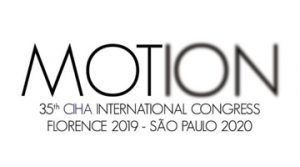
5th CIHA World congress in São Paulo – CALL FOR PAPERS
The CIHA Brazil Committee invites proposals for participation in nine Sessions, six Emerging Scholars Seminars, and a Special Session that will constitute the 35th CIHA World Congress – Motion: Migrations.
The Sessions, Emerging Scholars Seminars, and Special Session are detailed here: https://drive.google.com/file/d/1Qxyun9-gUje83bhCOGtt_d6p8EEMPmFF/view
New Media Caucus (NMC)
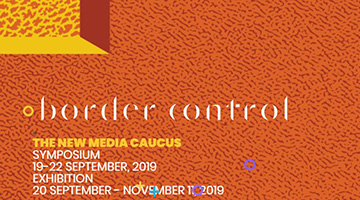 Border Control Symposium and Exhibition
Border Control Symposium and Exhibition
The New Media Caucus (NMC) is proud to present the 2019 Symposium and Exhibition, Border Control at the University of Michigan, Penny W. Stamps School of Art and Design and the Stamps Gallery. The symposium will take place on 19th – 22nd September, 2019, and the exhibition is from 20th September – 11th November, 2019. Keynote Speaker, Vinay Gupta will present a lecture, “Cities that will Walk Away” on 19th September at 5:10pm For more information about the events please visit our website: http://bordercontrol.newmediacaucus.org/
Design Incubation
Colloquium 6.1: Quinnipiac University
Design Incubation Colloquium 6.1 (#DI2019oct) will be held at the School of Communications at Quinnipiac University on Saturday, October 5, 2019.
https://designincubation.com/publications/colloquium/colloquium-6-1-quinnipiac-university/
Practicing Type in the Age of Screens
Saturday, November 9, 2019. 2-5pm. Type Directors Club, NYC
Typeface design and the implementation of typography has never been more exciting. In many cases, type is presented on monitors, tiny and huge electronic visual displays, i.e., screens. In collaboration with the Type Directors Club, Design Incubation will moderate a panel discussion among design innovators about their design and use of type in today’s changing environment. Panelists include Jason Pamental, Javier Mavromantes, Nancy Campbell.
CFP: The Fellowship Program at Design Incubation 2020
Call for Participation: 3-day academic design research and writing workshop in New York City. June 4-6, 2020. Application deadline, October 15, 2019.
Target Audience: Design academics in one or more of the following areas: graphic design, information design, branding, marketing, advertising, typography, web, interaction, film and video, animation, illustration, game design. Full-time tenure track or tenured faculty are given preference but any academic may apply.
https://designincubation.com/call-for-submissions/cfp-the-fellowship-program-at-design-incubation-2020/
CFP: The Design Incubation Residency at Haddon Avenue Writing Institute 2019
Rolling acceptances until Sept 30, 2019. Only 14 seats are available for this event. This 3-day residency allows researchers and scholars time to work on existing writing projects or to start a new writing project. The residency is open to design faculty and to those working in related fields.
https://designincubation.com/design-events/the-design-incubation-residency-at-haddon-avenue-writing-institute-2019/
CFP: A Day of Writing
Come spend an uninterrupted day working on a writing project.
Quinnipiac University School of Communications, October 6th 2019.
https://designincubation.com/design-events/a-day-of-writing/
CFP: Colloquium 6.3: Fordham University
Call for design research abstracts. Deadline: Saturday, December 28, 2019.
https://designincubation.com/call-for-submissions/colloquium-6-3-fordham-university-call-for-submissions/
Association of Art Museum Curators (AAMC)
Apply for AAMC Foundation’s 2020 Engagement Program for International Curators
The AAMC Foundation Engagement Program for International Curators is seeking eligible international and US-based curators interested in pursuing a year-long partnership dedicated to professional development and exchange.
At the core of this Program is a 12-month partnership between a non-US based curator (International Awardee) and a US-based curator (US Liaison) dedicated to reflecting on and developing self-identified areas of advancement with each other. Made possible by major support from the Terra Foundation for American Art, the Program includes travel funding for International Awardees, a participant stipend for US Liaisons, networking, and more, which are outlined in greater detail in the online application, available here: bit.ly/AAMCApply. Two pairings will be awarded.
Eligible applicants must be art curators working on or having worked within exhibitions and projects that explore historical art of the United States (c. 1500-1980), including painting; sculpture; works on paper, such as prints, drawing and photography; decorative arts; performance; and design (except industrial). Architecture and commercial film are excluded. Native American art is eligible for consideration. Additional requirements include a minimum of 50% of the time for/with non-profit organizations will be considered. Please note that curators working in four-wall collecting and non-collecting, community based, and non-four wall organizations, at any location in the globe are eligible.
Through fostering international relationships between curators, AAMC Foundation aims to not only provide opportunities for professional development and exchange, but also strengthen the international curatorial community and increase awareness of the concerns and needs of curators working outside the US. Visit our website to learn more: www.artcurators.org/page/GrantsTerra.
The online application for International Awardees and US Liaisons opens on Wednesday, September 11, 2019, and are due by 12pm ET on Thursday, October 24, 2019.
—
AAMC Foundation Webinar on Utilizing Community Advisory Groups
Join us on Tuesday, September 24, 2019 from 2:00 – 3:15PM ET to learn about the formation, implementation, and utilization of community partners and advisory groups from a dynamic speaker lineup.
From grassroots organizations to large, landmark institutions, museum teams are increasingly engaging with community members to bring history to bear on the narratives told and to bring forward the value of local knowledge. These consultations help develop and shape exhibition themes and checklists, open conversations on collecting practices and directions, and ensure that museum-generated programs accurately and genuinely reflect and engage their communities. From local focus groups to international convenings, the collaborative aspect welcomes perspectives outside the curatorial department.
This webinar explores a diverse range of current approaches, case studies, and lessons learned—from emerging grassroots efforts to established museum outreach. Speakers will address the value in engaging communities, best practices in developing partnerships and advisory groups, and ways to create meaningful and ongoing valued relationships.
Speakers include René Paul Barilleaux, McNay Art Museum; Adrian Locke, Royal Academy of Arts; Regan Pro, Seattle Art Museum; David Serkoak, Key Collaborator with the Canadian Museum for Human Rights; and Ben Tremillo, San Anto Cultural Arts.
There are only a limited amount of spots available. Registration is required: www.artcurators.org/event/communityadvisory
SHERA
The SHERA Board is pleased to announce that the SHERA Graduate Student / Independent Scholar Travel Grant for the 2019 ASEEES meeting has been awarded to Dr. Yulia Karpova (Central European University). Her paper, “Late Soviet studio ceramics as a site of institutional critique” will be presented during the SHERA-sponsored panel “Culture as Matter.”
International Review: Vibrancy In Stone: Masterpieces of the Đà Nẵng Museum of Cham Sculpture
posted by CAA — Aug 29, 2019
The following article was written in response to a call for submissions by CAA’s International Committee. It is by Swati Chembakur, an architectural historian at Jnanapravaha, a center for the arts in Mumbai, India. The author is also a 2019 alumna of the CAA-Getty International Program.

Vibrancy in Stone: Masterpieces of the Đà Nẵng Museum of Cham Sculpture, by Trần Kỳ Phương, V. Văn Thắng, and Peter D. Sharrock. Photographs by Paisarn Piemmettawat (Bangkok: River Books, 2018)
In 2018, the University of London’s School of Oriental and African Studies (SOAS) partnered with the Đà Nẵng Museum of Cham Sculpture in central Vietnam to produce a remarkable and visually striking centenary catalogue of its world-renowned collection of the sacred arts of the Cham people of Vietnam. The publication of Vibrancy in Stone: Masterpieces of the Đà Nẵng Museum of Cham Sculpture was timed to coincide with the renovation and expansion of the museum.
Beginning in the second century CE, settlements appeared along the central coast of what became Vietnam. The Chams probably migrated over the ocean from Borneo and were accomplished navigators. Their ports were the first call for any ship heading from China to India and the Arab world. Their role in the medieval maritime trade grew steadily and reached an apogee in the fourteenth and fifteenth centuries, when the great neighboring empire of Cambodia declined. The prosperity won from trade led to large scale temple construction earlier than the Cambodians.

Figure 1. Map of Cham archaeological sites in Vietnam
When tourism resumed in Vietnam after the wars of the twentieth century, the museum quickly became a prime attraction in the port city of Đà Nẵng. It is the world’s only museum devoted exclusively to the art of ancient Champa, the name given to the civilization of the Cham people. With 500 objects on display, its collection far outnumbers those in the Hanoi and Ho chi Minh City History museums, as well as the Musée Guimet in Paris.

Figure 2. Đà Nẵng Museum, Vietnam Photo: Trần Kỳ Phương
In the late nineteenth century, fifty sculptures were gathered by a French colonial administrator and amateur/enthusiastic collector, Charles Lemire, in a public garden at Tourane (Đà Nẵng), forming the embryo of the future museum collection. Some years later, French architect and archaeologist Henri Parmentier took charge of the neglected artworks and proposed a museum for their protection, which opened in 1919 (Fig. 2). He compiled the first comprehensive catalogue.
French colonial research formed the basis of Cham studies. Today a growing number of Vietnamese archaeologists and art historians are taking an active interest in this subject, expanding our understanding of the ancient art. Ethnic Cham scholars still remain few in number. Almost seventy years after Parmentier’s catalogue, a short guidebook to the museum was published about Cham history and art (Trần Kỳ Phương, 1987). It marked the first catalogue of the collection compiled by Vietnamese researchers and highlighted the link between Vietnamese and French research. After the devastating twentieth-century wars in Vietnam, some of the objects in Parmentier’s 1919 catalogue had disappeared, been damaged, or moved to other institutions. At the same time, many recently discovered artifacts have been added to the museum inventory.
Knowledge of Champa’s history, culture, and art, and an appreciation of its richness and uniqueness, has gradually progressed with the accumulation of new data and the engagement of various scholarly disciplines by both national and international scholars. Champa studies no longer appear in only French-language journals, as in the early twentieth century, but now attract a growing number of scholars from Europe, Asia, and North America, who work alongside Vietnamese experts.
Vibrancy in Stone is organized into two parts. Part I includes fourteen essays about the history and culture of Champa by Vietnamese and international scholars. Part II presents a stunningly illustrated chronology of Cham sculpture accompanied by meticulous descriptions and comments by contemporary scholars.
The introductory essay by museum director Vo Văn Thắng discusses the history of the museum, its collection, changing installations over the years, and the current renovation and expansion of the building. Subsequent essays by Kenneth Hall, John Whitmore and Đỗ Trường Giang address the importance of several Champa ports extending along the central Vietnam coast and their active role in the maritime trade network. Champa was probably never a unified state or kingdom but rather a series of loosely linked smaller polities. Its capitals were widely separated settlements on different parts of the coast, which took turns assuming hegemony over others.
Whitmore’s essay delineates fully for the first time the rise of Vijaya (in today’s Bình Đinh province) as the culture’s capital in the ninth century to its sudden demise in the fifteenth century.
Several essays address the Hindu-Buddhist religion, its rituals, archeology, and inscribed objects (by Shivani Kapoor, Ann-Valérie Schweyer, John Guy, Arlo Griffiths, Lâm Thị Mỹ Dung, and—full disclosure—myself) while others (by Trần Kỳ Phương and Parul Pandya Dhar) focus on the architecture, taking the reader through the history of Cham temples and highlighting the evolution of key construction techniques and design features that produced a series of tall, distinctive and elegant brick towers along the coastline (Fig. 3).

Figure 3. Mỹ Sơn valley temple displaying long, elegant brick sanctuaries Photo: Trần Kỳ Phương
The iconography of the beautiful and vibrant Cham sculptures erected in these towers—referenced in the catalogue title—is the subject of chapters by Thierry Zéphir, Grace Chiao-Hui Tu, and Peter D. Sharrock. Cham art has hitherto been almost exclusively studied through an Indic lens but Hui-Tu’s work brings out many new and unseen Sinitic aspects in Cham sacred art. For example, a ninth century monumental sandstone Buddha from Đồng Dương monastery is seated in the “European” position with pendant feet and palms resting on the knees (Fig. 4). While Buddhas seated with pendant legs can be found in Indian, Southeast Asian, and Chinese Buddhist art traditions, this particular hand posture is seen only in China and Đồng Dương.

Figure 4. Đồng Dương pedestal from Đồng Dương, Quảng Nam. 9th century, sandstone, 30 x 177 x 70 in. (76 x 449 x 389 cm); sandstone dais supporting the Buddha, 28 x 87 x 49 in. (70 x 222 x 124 cm). BTC 177-178 Photo: Paisarn Piemmettawat
The question of the relationship between Cham and neighboring Khmers forms the core of the paper by Peter D. Sharrock. Addressing the beautiful Khmer bronze of a naga-enthroned Buddha discovered by the French in the main Cham temple outside Vijaya, he points out that this icon was never part of Cham iconography. He then uses art historical and epigraphic evidence to untie a series of long-distorting knots in the history of the Khmer-Cham relationship.
Part II of Vibrancy in Stone focuses on masterpieces of the museum, one of which is the beautiful bronze illustrated in Figure 5, found in the Đồng Dương monastery in 1978. Earlier labelled as Tārā or Prajñāparāmita, here it has been correctly identified as the female aspect of Avalokitesvara and the main cult image of the monastery.
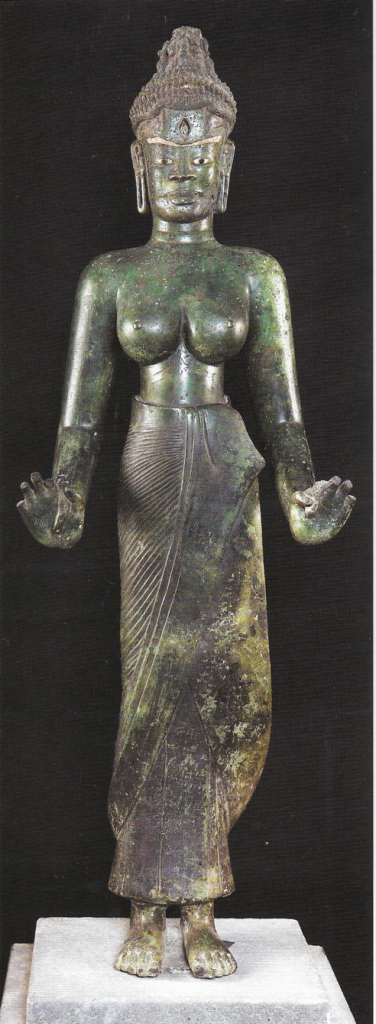
Figure 5. Lakṣmīndra-Avalokiteśvara, 9th century bronze found in the monastery of Đồng Dương. height 6 in. (115 cm). Attributes: lotus (right hand) and conch broken at the time of discovery. BTC 1651-BTĐN 535 Photo: Paisarn Piemmettawat
Other masterpieces include the most famous Mỹ Sơn Śivalinga pedestal (Fig. 6a-b), the only Cham sculpture that records the daily spiritual activities of ascetics performing rituals, practicing meditation, conversing, playing musical instruments, treating diseases, etc., and a widely acknowledge high relief of a Trà Kiệu dancer draped in beads (Fig. 7).

Figure 6a. Mỹ Sơn, 8th century temple pedestal displaying several daily ascetic activities, sandstone, 25 ½ x 107 x 131 in. (65 x 271 x 333 cm). BTC 6-22.4 Photo: Trần Kỳ Phương

Figure 6b. Details of the ascetic activities depicted on the Mỹ Sơn pedestal. Photo: Paisarn Piemmettawat
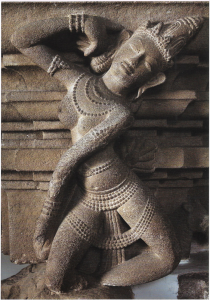
Figure 7. Trà Kiệu dancer/apsaras, Trà Kiệu, Quàng Nam, 11th century, sandstone, 43 x 106 in. (110 x 270 cm). BTC 118/1-22.5
Vibrancy in Stone brings together some of the most priceless and rare works of Cham art. As such, it proclaims the value and artistry of works by the Cham people whose heirs today are an ethnic minority in Vietnam. Equally important, it gathers together these beautiful and rare works of art as a resource for scholars, students, and connoisseurs alike.
Announcing New CAA Professional Committees
posted by CAA — Aug 08, 2019
CAA is pleased to announce the creation of two new professional committees: a Committee on Research and Scholarship, and a Services to Historians of Visual Arts Committee. The new committees were approved by the Board of Directors at their May 2019 meeting. Concurrent with our annual call for new committee members, we seek applicants to form the inaugural teams for these two new committees.
The deadline for these applications is October 1, 2019, for new committee service to begin at the Annual Conference in February 2020.
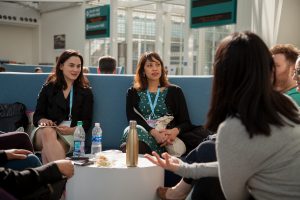
Discussion group at 2018 CAA Annual Conference. Photo: Rafael Cardenas
The formation of these new committees responds to requests from our membership and to a desire to be forward-looking in addressing the professional needs of our fields.
The Committee on Research and Scholarship will offer a resource to all members engaged in the production or consumption of scholarly research.
The Services to Historians of Visual Arts Committee will identify and address concerns facing the historian members of our organization (encompassing specialists in any facets of art, architecture, design, material culture, and visual culture).
The Services to Historians of Visual Arts Committee is intended to recognize our organization’s enduring support for historians, offering them a presence and a voice similar to the role played by other profession-specific committees in our organization (such as the Services to Artists Committee and the Committee on Design). As noted in the committee charge, the Services to Historians of Visual Arts Committee “offers a forum for the discussion of issues of mutual interest across the discipline’s many diverse fields and methodologies. In a climate of great threat to the survival of history of art and history of visual arts programs, this committee provides a locus for advocacy issues particular to historians in these areas of interest.” It is understood that the committee will play an active role in the Annual Conference but is also intended to serve as a central hub and resource for communication among historians of the visual arts well beyond the chronology of conference programming.
As stated in the committee charge, the Committee on Research and Scholarship is charged with “gathering information, [and] assessing and proposing organizational advocacy for CAA on matters concerning the research and scholarship in visual arts and design, encompassing all facets of research regarding history, theory, education and practice.” Specialists in the visual arts—whether practitioners or historians—face unique challenges in the production of their scholarship, such as the cost of image permissions, the closures or reorganization of academic presses, and/or the misalignment of the multiyear workflow of exhibitions or excavations against the strictures of a tenure clock. A scholar’s type of institutional affiliation, or independent scholar status, has an enduring impact on the types of research and scholarship that can be produced—arguably in more profound ways than in other humanities or arts fields. The Committee on Research and Scholarship will provide a vital hub to our members interested in addressing any of these areas of concern—or advancing other concerns or questions concerning the area of research and scholarship.
If you wish to apply for either of these new committees, send an email to Vanessa Jalet at vjalet@collegeart.org with a brief statement of interest and attach a reduced résumé (no more than 2-3 pages).
Kindly also enter in the subject line: “Applicant for Committee on Research and Scholarship” or “Applicant for Services to Historians of Visual Arts Committee”
Deadline: October 1, 2019
Committee on Research and Scholarship Charge
The Committee on Research and Scholarship is charged with gathering information, assessing trends, and proposing organizational advocacy for CAA on matters concerning the advancement of research and scholarship in visual arts and design, encompassing all facets of research regarding history, education, and practice. Recognizing that professionals must navigate a rapidly-transforming field of options for conducting research and disseminating the results thereof, the committee is responsible for assisting the organization in engaging with current issues and serving its membership in this important facet of their professional life.
Services to Historians of Visual Arts Committee Charge
The Services to Historians of Visual Arts Committee identifies and addresses concerns facing historians of art, architecture, design, material culture, and visual culture. It creates and implements programs and events at the conference and beyond. It offers a forum for the discussion of issues of mutual interest across the discipline’s many diverse fields and methodologies. In a climate of great threat to the survival of history of art and history of visual arts programs, this committee provides a locus for advocacy issues particular to historians in these areas of interest. The Committee lends support and mentorship for both seasoned and emerging professionals. It is also charged with maintaining dialogue with other professional organizations and affiliated societies focused on the history of art, architecture, design, material culture and visual culture.
The CAA-Getty International Program: Looking Forward, Looking Back
posted by CAA — Aug 01, 2019
This article was written by Janet Landay, project director of the CAA-Getty International Program since its inception.
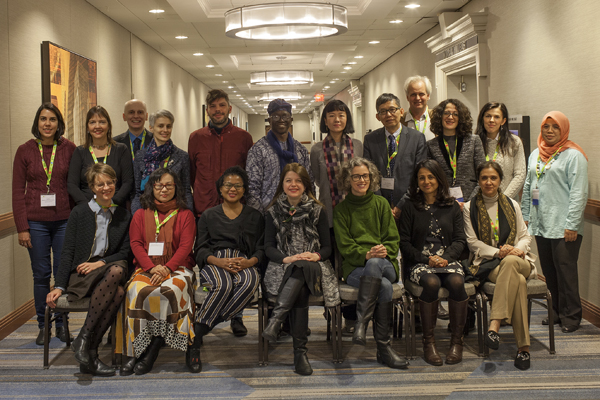
2019 participants in the CAA-Getty International Program, photographed at the Annual Conference in New York. Photo by Ben Fractenberg
This is open season for the CAA-Getty International Program; that is, we’re accepting applications from international scholars between now and August 23rd to participate in next year’s program at the Annual Conference in Chicago. This will be the ninth year of the program and we’re looking for academics, curators, or artists who teach art history from countries not well represented in CAA’s membership (primarily non-Western countries from the global south, all parts of Asia, and Eastern Europe). Specifically, we want to bring scholars who are advancing our understanding of the visual arts, be it through art history, visual studies, or any number of intersecting disciplines, such as aesthetics, history, post-colonial studies, gender studies, cultural heritage research, etc. The range of topics addressed by participants since the program began nine years ago is remarkable, as exemplified in last year’s programs included at the end of this article.
The mission of the CAA-Getty International Program is to bring new voices to the CAA community to enrich the conversation about globalization and inclusion in visual arts scholarship. Since it began in 2012, the program has brought 120 scholars from 46 countries to its conferences, including representatives from Argentina, Albania, Bangladesh, Benin, Brazil, Bulgaria, Burkina Faso, Cameroon, Chile, China, Croatia, Cuba, Czech Republic, Ecuador, Egypt, Estonia, Ghana, Greece, Haiti, Hungary, Iceland, India, Iran, Iraq, Lebanon, Malaysia, Mexico, New Zealand, Nigeria, Pakistan, Peru, Poland, Portugal, Romania, Russia, Serbia, Slovakia, South Africa, South Korea, Sri Lanka, Taiwan, Thailand, Turkey, Uganda, Ukraine, and Vietnam. Many of these scholars have returned to CAA conferences as speakers, session chairs, and members of CAA’s International Committee. They have also contributed articles to CAA’s publications and collaborated with scholars in the United States that they met while attending a conference.
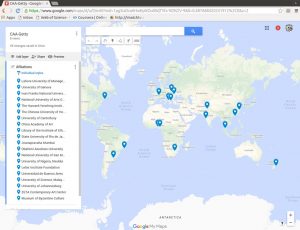
Map showing home countries of 2019 CAA-Getty International Program participants. Map provided by Nazar Kozak.
Each year, US-based CAA members serve as hosts to the international scholars, introducing them to colleagues, guiding them through the conference’s vast array of sessions and programs, and frequently taking them to museums and collections in town. To date, over 60 CAA members have participated in the program, supported with honoraria from the National Committee for the History of Art.
In 2020, we will bring fifteen new scholars and five alumni to the Chicago conference. Please help us spread the word of this grant opportunity to colleagues or institutions in the regions mentioned above by sharing this link to the program’s description and application.
And if you would like to participate as a host, send me an email at jlanday@collegeart.org.
What follows is the program for two key events from the 2019 CAA-Getty International Program: a preconference colloquium on February 12th on international issues in art history at which twenty scholars participated, and an alumni conference session on February 14th that featured five CAA-Getty alumni. Included below is the program for the February 12th colloquium, followed by the abstracts for the February 14th alumni conference session.
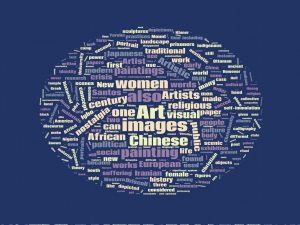
Word cloud showing most frequently used words in the 2019 Preconference Colloquium of the CAA-Getty International Program. Illustration provided by Nazar Kozak.
PROGRAM
GLOBAL CONVERSATIONS 2019
PRECONFERENCE COLLOQUIUM
Tuesday, February 12, 2019
Starr Foundation Hall, Parsons School of Design
8:30 AM Coffee, welcome, and introductions
9:15 AM Examples of Defining or Constructing Aesthetics in Chinese and Japanese Art
Chair: Chen Liu, Harvard-Yenching Institute, Harvard University, 2018-19
The Making of Scenic Sites: Landscape Painting, Tourism and Nationalism in Republican China
Pedith Chan, Chinese University of Hong Kong
Art by Japanese Prisoners in New Zealand during WWII
Richard Bullen, University of Canterbury, New Zealand
Lucy Driscoll and Developing a Theory of Chinese Painting
Jian Zhang, China Academy of Art, Hangzhou
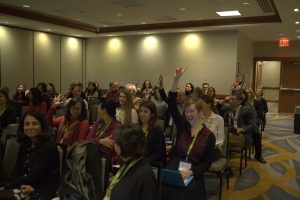
CAA-Getty International Program preconference colloquium, February 12, 2019. Photo by Ben Fractenberg
10:30 AM Orientalism/Occidentalism
Chair: Nadhra Khan, Lahore University of Management Sciences, Pakistan
From Occidentalism to an Occidentalizing Art: An Iranian Gaze to the Occident
Negar Habibi, University of Geneva, Switzerland
Deconstructing Imperialism: The Intersection of Religion, Politics, and Design in the Iconography of a Christian Saint
Halyna Kohut, Ivan Franko National University of Lviv, Ukraine
Orientalism and Female Portraiture in Nineteenth-Century Painting in Romania
Oana Maria Nicuță Nae, George Enescu National University of Arts, Iasi, Romania
11:45 AM How Do We Approach Religious Art?
Chair: Nazar Kozak, Department of Art Studies, Ethnology Institute, National Academy of Sciences of Ukraine
The Last Judgment in Spanish America as Social Rhetoric of Salvation and Damnation
Tamara Quírico, State University of Rio de Janeiro, Brazil
Dancers, Musicians, Brahmins and Ṛṣis: Understanding the Temple Worship of the Pāśupata sect in Angkor, Cambodia
Swati Chemburkar, Southeast Asian Art and Architecture, Jnanapravaha, Mumbai, India
You Cannot See It: Access to Religious Artistic Materials
Stephen Fọlárànmí, Ọbáfémi Awólọ́wọ̀ University, Ilé-Ifè, Nigeria
1:00 PM Lunch
2:30 PM The Body, Identity, and Artistic Agency
Chair: Katarzyna Cytlak, Center for Slavic and Chinese Studies, University of San Martín, Argentina
Shifting Female Identity: Female Cross-dressing in Southeast Nigeria
Chukwuemeka Nwigwe, University of Nigeria, Nsukka
Challenging the “Unconscious”: Agnaldo Manoel dos Santos and the Revision of Afro-Brazilian Art
Juliana Ribeiro da Silva Bevilacqua, University of Campinas (Unicamp), Brazil
The Reinvention of the Body in Volatile Times: Political and Artistic Intersections between Buenos Aires and New York in the 1980s
Viviana Usubiaga, National Scientific and Technical Research Council (CONICET), University of San Martín/University of Buenos Aires, Argentina
3:45 PM Politics and Art in Dark Times
Chair: Sarena Abdullah, School of the Arts, Universiti Sains Malaysia, Penang
A Flame For Freedom
Marko Stamenkovic, ZETA Contemporary Art Center, Tirana, Albania
Sanitizing Memory through Erasure: Post-apartheid Nostalgia in Contemporary Visual Art Practice
Zamansele Nsele, University of Johannesburg, South Africa
The Crisis Displayed: Greece’s Participation at the Venice Art Biennale
Iro Katsaridou, Museum of Byzantine Culture, Thessaloniki, Greece
5:00 PM Wine Reception
GLOBAL CONVERSATIONS 2019
ALUMNI CONFERENCE SESSION
ABSTRACTS
Thursday, February 14, 2019
Creative Pedagogy: Mapping In-between Spaces Across Cultures
Nazar Kozak (Chair), National Academy of Sciences of Ukraine
Art-historical curricula tend to provide imaginary “racks” on which each artwork could be assigned to chronological and geopolitical shelves. In practice, however, such systems has difficulties in accommodating phenomena that fall in-between proposed categorizations. Their presence in art-historical classrooms corresponds to cosmology ‘s Dark matter: it shapes the Universe while remains directly unobserved. Hybrid phenomena have produced an important impact on art scenes across historical periods and cultures, and illumination of this impact plays crucial role in making art history more fully global discipline. This session addresses cross-cultural entanglements and overlaps in which borders looses their fix and reveals their porosity. Structured around creative pedagogy it discusses specific historic cases from the teaching perspectives moving towards inclusive and collaborative paradigm especially in mixed-class environments engaging students and faculty from different countries. The panelist, who are the CAA-Getty International Program alumni from Asia, Latin America, and Eastern Europe, share their teaching methods that proves efficiency in navigating across cultures as well and theoretical optics providing optimal focus on transcultural dialog and reciprocal enrichment.

From left to right: Chen Liu, Nazar Kozak, Katarzyna Cytlak, Nadhra Shahbaz Khan, and Sarena Abdullah at the CAA-Getty International Program alumni conference session, February 14, 2019. Photo by Ben Fractenberg
An Italian in China: The Curious Case of Giuseppe Castiglione
Chen Liu, Tsinghua University
What happens when China and the West encounter each other? A clash of traditions may generate unexpected art forms that defy categorization, as tellingly revealed in the life and works of the multi-talented Italian Jesuit artist Giuseppe Castiglione (1688-1766), court painter to three Qing Emperors. Despite his popularity in China both during and after his lifetime, he is surprisingly little known in the West beyond those who specialize in classical Chinese art, with sparse literature in languages other than Chinese (mainly in Italian and French). Existing studies of Castiglione’s works, focusing largely on his paintings, tend to emphasize the “Western” trend he initiated in early modern China or his fusion of “European” and “Chinese” traditions, leading to oversimplification of both. A novel teaching course featuring cultural hybridity in both its subject and audience (a mixed group of Chinese and Western students) may help address such problems of transcultural interpretation and reception as exposed by the curious case of Castiglione. Using Castiglione’s art – painting, decoration and architecture – as a mirror, and by posing previously neglected questions such as “what is ‘non-Chinese’ or ‘non-Western’ in his works, and “which ‘Chinese’ and ‘European’ artistic styles/techniques did he adopt, adapt, or reject”, the course seeks to stimulate more profound reflections on the sophisticated, sometimes ambiguous traditions of both Chinese and European art, their compatibility and incompatibility, and to illuminate the confused in-between areas.
Pedagogy of the Transborders: Reviewing East European art from the perspective of transatlantic cultural exchanges with Latin American and African cultures
Katarzyna Cytlak, Centro de Estudios de los Mundos Eslavos y Chinos, Universidad Nacional de San Martín
Developed since the 1990s by Latin American thinkers, decolonial theory became an effective tool to teach East European art. Concepts, such as “border thinking” (Walter Mignolo) and “transmodernity” (Enrique Dussel), which dealing with bicultural identity in Latin America and postulating a non-hierarchical, inter-epistemic dialogue between cultures, offer a new framework to reconsider transatlantic artistic exchanges and cultural polarizations within the European continent. The paper will analyze how transmodern and decolonial approaches could shed new light on East European art and its dialogue with non-Western cultures. Quotations of customs and rites from Polish folklore by the Polish/Mexican artist Marcos Kurtycz were the result of his biculturalism, as well as an artistic strategy aiming at distinguishing himself on the Mexican scene. Self–identification with African cultures and politics by the Polish artists of the 1980s (Marek Sobczyk, The Luxus Group) could be explained as proof of the artists’ criticism of the Non-Aligned Movement, the symptom of their “radicalized utopian inclusivity” (Boris Groys), and as their critical comment on the late Socialist societies in the processes of Westernization.
Images of Guru Nanak: Locating Patterns of Words in Images
Nadhra Shahbaz Khan, Lahore University of Management Sciences
Traditional arts in the Indian subcontinent are strongly allied to oral traditions and to written text including both folklore and literature. Examples of these abound in secular and religious realms and are manifest in a large body of miniature paintings and murals showing the Hindu stories of Heer-Ranjha, Sassi-Punnoo and Dhruv Bhagat and relief panels illustrating Buddhist jataka tales and Hindu epic poems such as the Ramayana and Mahabharata. This paper maps the depiction of Guru Nanak, the first of the ten Sikh gurus, and their dependence of the Indian visual vocabulary taken from folklore, literature and cultural practices. He is usually painted with a fixed set of attributes, each laden with references to cultural practices and beliefs: some long forgotten, others have remained current until this day. Modern interventions however, have obscured meanings of many of these concepts and practices making it difficult today to fully understand their significance in their iconographic program. Refreshing the forgotten relationship between the word and image promises to lead to creative pedagogical possibilities where realms of imagination, rendition and performance can be navigated to connect not only with the creators and viewers of art but also the ones who dwell in it.
Cross Cultural Encounters through Creative Pedagogy in Teaching Art History
Sarena Abdullah, Universiti Sains Malaysia
This paper explains and discuses my recent and first Collaborative Online International Learning (COIL) with an American university within the context of students’ cross-cultural encounters imbedded through Art History subject(s). In the 15 weeks of Malaysian Modern Art (VHS 202) and Selected Topics In Asian Art (ARTH 294) class, my American collaborator and me, designed and aligned our art history classes pedagogy cross-culturally taking in various considerations of Malaysian and American context into our teaching outcome. This paper will discuss how we have adopted and adapted the COIL module in our own classes, and innovate our collaborative engagements using Facebook as our main platform. From tasks such as personal introductions of students from both Malaysian and American classes, group videos of their cultural/national background, to producing group videos on artworks and /or material culture from local institutions, to completing cross collaboration group work tasks—this pedagogical approach had managed to expose students to different cross-cultural realities and encounters (and even time zones) weaved into their learning experiences. This paper will discuss the context of such creative pedagogy in the context of how Art History can also be a platform to disseminate creative knowledge today.
Apply to the 2019 CAA-Getty International Program
An Interview with Amy Meyers, Recently Retired Director of the Yale Center for British Art
posted by CAA — Jul 26, 2019
In June, Amy Meyers ended a long and fruitful career as Director of the Yale Center for British Art, which she led for seventeen years. Prior to her appointment in 2002, she spent much of her career at research institutes including Dumbarton Oaks; the Center for Advanced Study in Visual Arts at the National Gallery of Art, Washington, DC; and The Huntington Library, Art Collections, and Botanical Gardens. She also taught at the California Institute of Technology, the University of Michigan, Mount Vernon College, and Yale, and has written extensively on the visual and material culture of natural history in the transatlantic world.
Joelle Te Paske, CAA Media and Content Manager, corresponded with Amy over email to reflect upon her tenure at the YCBA, her experiences with CAA, and her plans for the future. Read the interview below.
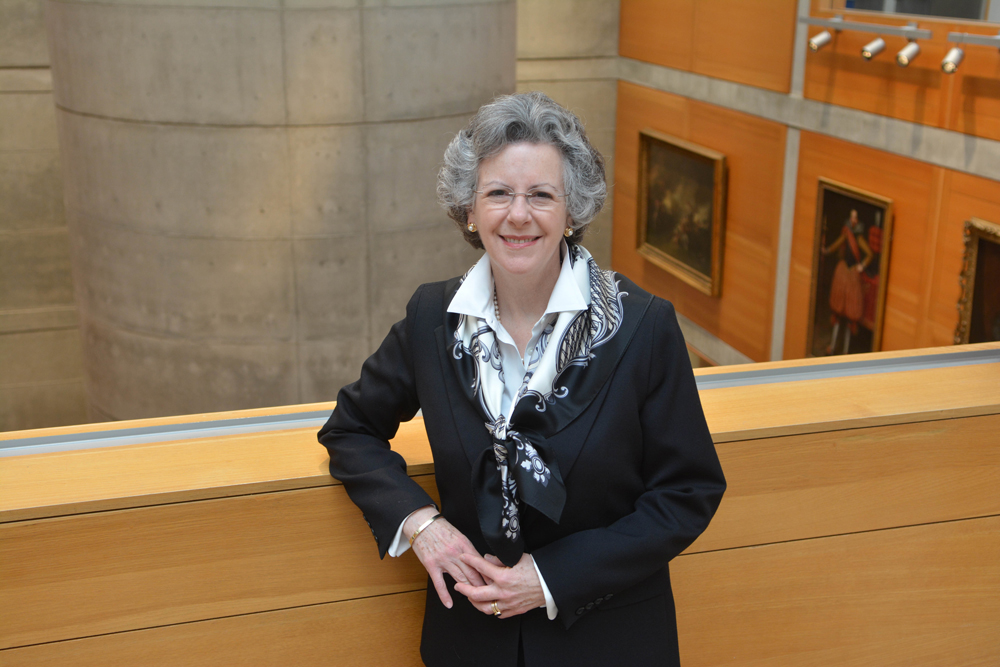
Amy Meyers, Yale Center for British Art, photo by Michael Marsland
Joelle Te Paske: Amy, thank you so much for speaking with us. To begin, what pathways led you to the Yale Center for British Art (YCBA)?
Amy Meyers: There is no question that my experiences as a graduate student at Yale set the stage for my return to direct the Yale Center for British Art 25 years following my arrival as a doctoral candidate in American Studies, in the fall of 1977—the first year the magnificent collections of the newly opened YCBA were accessible to students.
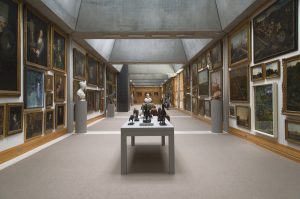
Long Gallery after reinstallation, Yale Center for British Art, photo by Richard Caspole
I had come to Yale to write a dissertation on the photographers who accompanied the federal geological surveys of the American West following the Civil War, and my interest in the art of empire brought me to explore the staggering collections of paintings, prints, drawings, maps, rare books, and manuscripts amassed by the Center’s founder, Paul Mellon, relating to the depiction of the natural world, particularly in the Americas.
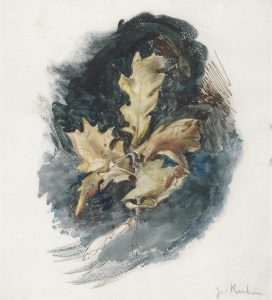
John Ruskin, Study of an Oak Leaf, undated, pen and brown ink with watercolor over graphite heightened with gouache and gum; verso: graphite on paper, Yale Center for British Art, Paul Mellon Collection
The following spring, I enrolled in one of the first courses held at the Center—a seminar on Ruskin, taught by George Hersey. That course included students not only from the Department of the History of Art, but others, who, like me, were interested in the influence of Ruskin’s thought on many aspects of culture, particularly science. Professor Hersey’s important consideration of Ruskin as a major thinker of the nineteenth century, and the discussions that took place in that class between and amongst students, were foundational to my graduate education. I formed collegial friendships with many students who would go on to contribute significantly to art historical scholarship, both in academe and in museums, including David Curry, Bruce Robertson, George Shackelford, Mark Simpson, and Scott Wilcox—and these friendships have informed my scholarship and influenced the way in which I have approached the programs I have had the privilege to run, from the Virginia Steele Scott Gallery of American Art at the Huntington Library, Art Collections, and Botanical Gardens, to the YCBA.
The interdisciplinarity of Professor Hersey’s class reflected Yale’s commitment to exploration across disciplinary boundaries in many areas of study—a commitment that was unusual at American universities in the 1970s. Jules Prown, who had been the YCBA’s first director, creating the institution in concert with Paul Mellon and a distinguished committee of Yale faculty members, was himself devoted to examining the history of art from a broad range of vantage points, and he and his colleagues built that approach into the Center’s culture, both as a research institute and as a public museum with teaching at its heart.

Unidentified man, Paul Mellon, Kenneth Froeberg, and Jules Prown, during the construction of the Yale Center for British Art, 1974, photo by William B. Carter, Yale Department of Public Information, Institutional Archives, Yale Center for British Art
I was privileged not only to study with Jules, but to have him as one of my dissertation advisors. I learned from him the value of the close examination of objects as primary to art historical research, as well as the importance of working collaboratively with groups of scholars in developing the richest, most productive, and enjoyable of research communities. Jules drew around him, through his exciting classes and seminars, a large and devoted coterie of students from across the university who were interested in cross-cultural studies, including art history and material culture—a field he was instrumental in driving forward. Many of the students who took George Hersey’s seminar were part of this group; but others, including Margaretta Lovell (who by then was teaching a course on material culture with Jules), David Lubin, Angela Miller, Rodger Birt, Esther Thyssen, Buffy Easton, Valerie Steele, Catherine Lynn, Rebecca Zurier, Kenneth Haltman, Alexander Nemerov, Richard Powell, and Helen Cooper (who already was serving as Curator of American Paintings at the Yale University Art Gallery) also were active members of Jules’s circle of students (and there were many others who were off writing dissertations, such as Kathleen Foster, or who had graduated relatively recently and were known to us by their groundbreaking work, such as David Solkin). At that time, Bryan Wolf was a young professor of English literature and American Studies who had developed a strong interest in American art, and he also was an important member of Jules’s circle. I was tremendously privileged to have Bryan as one of my dissertation advisors, as well.
The sadly short-lived Center for the Study of American Art and Material Culture, directed by Richard Beard, was established by Robert McNeil, through the Barra Foundation, at the Yale University Art Gallery in the same year that the YCBA opened.
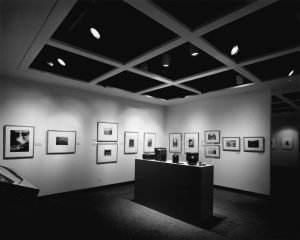
A Survey of American Photographs 1840–1940, installation as presented from March 28–June 6, 1978, organized by the Yale Center for American Art and Material Culture, photo courtesy of the Yale University Art Gallery Institutional Archives
This center both reinforced the community of Americanists at Yale and gave me the opportunity to curate the first of my own exhibitions, American Photographs: 1840 to 1940. The group of Western American historians fostered by my third dissertation advisor, Howard Lamar, and Archibald Hanna, the then-curator of Western Americana at the Beinecke Rare Book and Manuscript Library, also promoted a culture of intellectual exchange, focused quite centrally on the visual culture of the West. Additionally, the American Studies Program offered students and faculty members with cross-disciplinary interests a supportive environment that encouraged innovative, experimental approaches to the study of American culture across the board. Collectively, these centers and programs taught graduate students of my generation at Yale the value of being a member of an engaging and supportive community of intellectual interchange, supported institutionally, and I have no doubt that this experience influenced my interest in being involved in study centers over the course of my professional career.
Indeed, as a graduate student, I was introduced to the vibrant culture of international research institutes when I was awarded a junior fellowship at Harvard University’s Washington-based research institute, Dumbarton Oaks (DO), my dissertation topic having shifted to a broader consideration of the relation of the visual arts to the natural sciences, from the colonial period, through the establishment of the republic, and into the nineteenth century. Some of my closest collegial friendships were formed in the community of DO, including my life-long professional partnership with Therese O’Malley, with whom I presently am organizing an exhibition on John and William Bartram and the emergence of environmental thought in America.
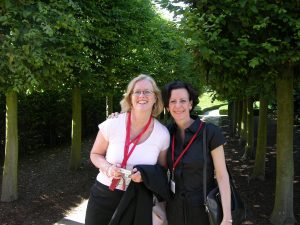
Therese O’Malley and Amy Meyers at a conference at the Royal Botanic Gardens at Kew, 2005.
Therese and I were privileged to be hired by the first dean of the Center for Advanced Study in the Visual Arts (CASVA), at the National Gallery, Henry Millon, to work as predoctoral research assistants for the Architectural Drawings Advisory Group, an international consortium convened at CASVA and supported by the J. Paul Getty Trust to set standards for the scholarly cataloguing of architectural drawings online. This early experience in working with an international group of scholars on one of the first electronic database projects in the history of art stimulated my life-long dedication to advancing the development of electronic tools for art historical research—one that I brought to the Yale Center for British Art when I became director.
The collective of fellowship programs in art history across the museums and research institutes of Washington, DC offered me a rich community of peers as an advanced graduate student and young professional, and this stimulating environment furthered my interest in working within the context of a study center, which had begun at Yale. The appeal of funding art historical research (and research in the humanities more generally) through grants and fellowships was strengthened by the work of my husband, Jack Meyers, an assistant director in the Research Division at NEH at that time—and we have been most fortunate to have developed comparable careers in this regard. While I worked for fourteen years as the Curator of the Virginia Steele Scott Gallery of American Art at the Huntington, which is one of the largest residential fellowship-granting research institutes in the humanities in the world, Jack served as a program officer and then deputy director of the Getty’s Grant Program (now Foundation). We both became fully committed to the support of scholarship internationally, and, over the last years, while I have served as director of the Yale Center for British Art, and CEO of the Paul Mellon Centre for Studies in British Art (PMC) in London, Jack has served as President of the Rockefeller Archive Center. Our complementary positions have allowed us to share our experiences in the running of study centers, which has been wholly gratifying, and, I hope, of benefit to our mutual institutions.
JTP: What would you say are some of the biggest changes you’ve seen during your time at the YCBA?
AM: Certainly the greatest change I have seen in the field of British art over the last seventeen years, which has affected the YCBA and PMC in fundamental ways, and to a certain extent has been promoted by these sister institutions, has been a major shift in vantage point from what commonly has been called the “imperial gaze” to a more global viewpoint. Although by the time I was named director of the YCBA seventeen years ago, the approach to British art had become as much concerned with social history as with connoisseurship, works still were interpreted largely in terms of a relatively closed history of European art. The complex and tragic histories of the British Empire and slave trade were only beginning to affect the ways in which British art was understood, and the canon remained essentially defined as the creation of white, male artists of British birth—or, more generously, of white, male European or colonial American artists who came to practice in the British Isles, or who were associated with British artists and patrons on the Grand Tour.
Over the last years, a sea change has taken place, and not only has the canon expanded—and shifted—to include works by artists from many other parts of the world that came under British dominion or were deeply affected by the Empire, but also by artists of more diverse racial backgrounds and genders. The sense of the West’s ownership of the world on the part of historians of British art has been altered dramatically, and standard practice now insists that even the most traditionally canonical works must be reinterpreted from a global vantage point, and in terms of much larger and more challenging histories.
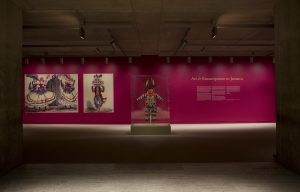
Art and Emancipation in Jamaica: Isaac Mendes Belisario and his Worlds, curated by Tim Barringer, Gillian Forrester, and Barbaro Martinez Ruiz, Yale Center for British Art, 2007, photo by Richard Caspole
JTP: What is a favorite memory—perhaps one that is less well-known—from your time there?
AM: My fond memories from my years at the YCBA—and the PMC—are innumerable, and it is extremely difficult to select a favorite. However, one program stands out as particularly memorable for me personally. In July of 2005, the YCBA co-organized a conference entitled, “Ways of Making and Knowing: The Material Culture of Empirical Knowledge,” with the PMC and the Wellcome Trust Center/Centre for the History of Medicine at University College London (UCL).
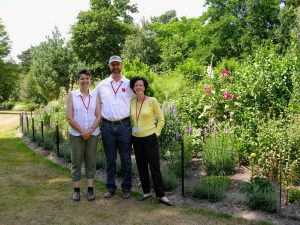
Pamela Smith, Harold Cook, and Amy Meyers, standing in front of a raised flower bed reconstructed from an eighteenth-century plan by garden historian Mark Laird, at Painshill Park, in Cobham, Surrey, during the final session of “Ways of Making and Knowing: The Material Culture of Empirical Knowledge,” July, 2005.
My co-conveners were close associates in the history of science: Pamela Smith, who is the Seth Low Professor of History at Columbia University, and Harold Cook, who, at that time, was director of the Wellcome Trust Center and now is the John F. Nickoll Professor History at Brown University. Beginning with a series of discussions at the Huntington, we planned an interdisciplinary conversation about the material construction of knowledge, examining how artisans and other makers of things informed the ways in which the natural world came to be understood in the West, from the sixteenth-century through the nineteenth. Exploring the relationship between two spheres traditionally understood to be distinct—practical and theoretical knowledge, the lectures and demonstrations were given by the seventy presenters, including art historians and historians of material culture, historians of science, artists, and craftspeople.
The program took place over five days, at sites across London ranging from the Chelsea Physic Garden, the Enlightenment Gallery at the British Museum, the Royal Botanical Gardens at Kew, the Natural History Museum, the Linnean Society, the V&A, and Painshill Park, in Surrey. This experimental program included as many object-study sessions and hands-on making workshops as formal papers, interrogating how the use of natural materials in the processes of making yielded the most profound understanding of nature, feeding science as much as technical knowledge in exciting new ways. A selection of the papers appeared under the title of the conference, in the Bard Graduate Center’s series Cultural Histories of the Material World, published by the University of Michigan Press in 2014. I must say that the support of Brian Allen, at that time the splendid and long-serving Director of Studies of the PMC with whom I had the honor of working closely for ten years, was a special pleasure.
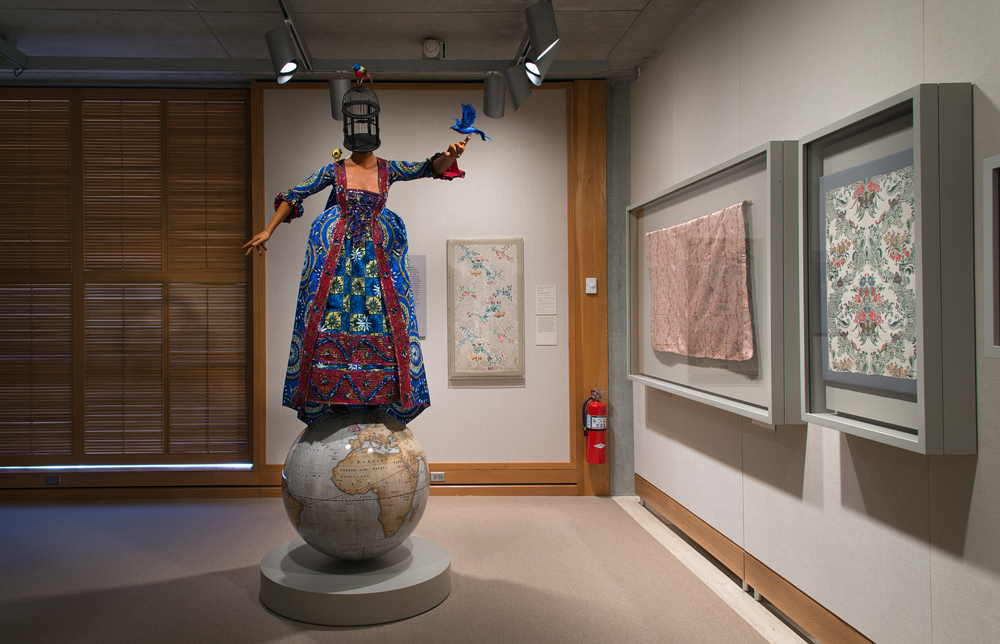
Enlightened Princesses: Caroline, Augusta, Charlotte, and the Shaping of the Modern World installation, including Yinka Shonibare CBE’s Mrs Pinckney and the Emancipated Birds of South Carolina (2017), Yale Center for British Art, photo by Richard Caspole
I also remember with great fondness working with Joanna Marschner, Senior Curator at Kensington Palace, on Enlightened Princesses: Caroline, Augusta, Charlotte, and the Shaping of the Modern World, an exhibition co-organized by the YCBA and Historic Royal Palaces, with the support of the PMC, that was mounted in New Haven and London in 2017. Our mutual interest in women and patronage, particularly in relation to the natural sciences, found its expression in this project, and we look forward to working together on the subject long into the future.
JTP: What is a resource at the YCBA that you think people don’t often know about, but should?
AM: The collection of British art at the YCBA is renowned as the largest and finest outside the UK, comprising over 2,000 paintings; 20,000 drawings and watercolors; 45,000 prints and photographs; and several hundred pieces of sculpture. Much less well known is the institution’s truly glorious rare book and manuscript collection. The Center’s founder, Paul Mellon, began his life as a collector in this field, and over his lifetime he amassed one of the greatest collections formed in the twentieth century, comprising approximately 35,000 titles. Mr. Mellon focused in part on British illustrated books, acquiring the renowned J.R. Abbey collection of British color plate books, which serves as the touchstone for all other collections of this kind. Other major parts of the collection include drawing manuals, sporting books and manuscripts, early maps and atlases, early printed books by Caxton and his contemporaries, and archival and manuscript material relating to British artists, writers, and travelers of all periods.
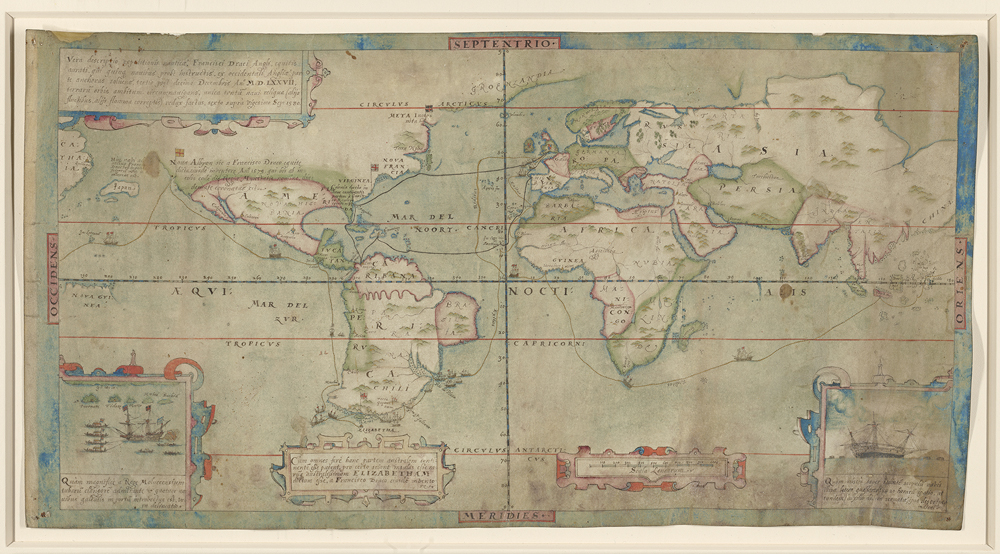
A True Description of the Naval Exploration of Francis Drake, Englishman & Knight, Who With Five Ships Departed from the Western Part of England on 13 December 1577, Circumnavigated the Globe and Returned on 26 September 1580 with One Ship Remaining, the Others Having been Destroyed by Waves or fire, [London (?), ca. 1587], pen and ink and watercolor on parchment, Yale Center for British Art, Paul Mellon Collection
The Rare Books and Manuscripts collection contains splendid photographic holdings, beginning with some of the earliest printed books including original photographic illustrations produced by the first British experimenters with paper-print photography, such as William Henry Fox Talbot. These collections have grown enormously over the years, as have the photographic collections in the Prints and Drawings Department, making the Center one of the most significant repositories of British photographs in the country.
The same holds true for the development of the institution’s collection of contemporary British art, and over the course of this summer, the Center has mounted an exhibition illuminating the role that donors have played in enhancing both areas of the institution’s collections over the last few years. Entitled Photographs/Contemporary Art: Recent Gifts and Acquisitions, the exhibition demonstrates the breadth and depth of these holdings and signals their continued growth.
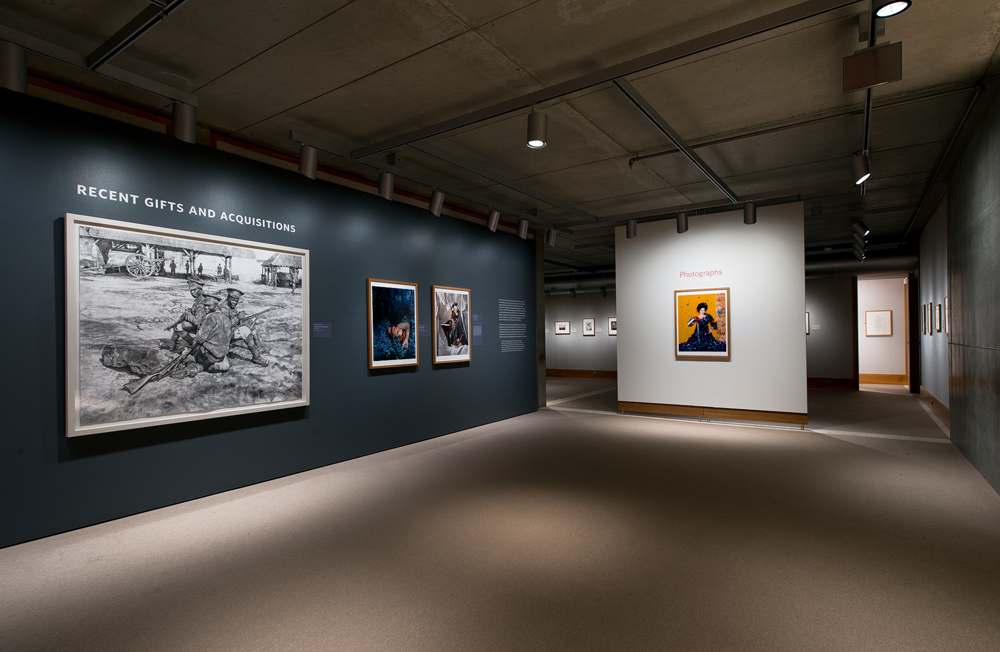
Photographs | Contemporary Art: Recent Gifts and Acquisitions installation, Yale Center for British Art, photo by Richard Caspole
JTP: When did you first become a CAA member? Do you have a favorite memory from a CAA conference?
AM: I have been a member of the CAA for so long that I do not remember precisely when I joined—undoubtedly by the early 1980s, when I was attending conferences regularly in my later years of graduate school. My memories of the very first conference I attended are shrouded in the mists of time, but I believe that I joined a group of Yale graduate students at a conference in New York while I was still enrolled in courses, in the late 1970s.
I have countless happy memories from conferences throughout the years, from sessions I have co-organized on the visual and material culture of natural history with my long-standing colleague, Therese O’Malley, to the multitude of fine papers given by scholars in my own fields of American and British art. Of course, one of the most important functions of the conference is to introduce participants to subjects that lie beyond their own areas of expertise, and I have learned an enormous amount from papers on topics to which I have had little exposure, especially as art history has evolved in such exciting ways over the last years. New methodological approaches are always stimulating to consider, and I particularly have enjoyed learning from the work of younger colleagues. Indeed, the call for papers for next year’s conference promises a rich and important group of sessions that will have me running from one talk to the next throughout the proceedings.
Since 1989, due to my association with The Huntington and the YCBA and PMC, I have had the pleasure of attending the winter meeting of the Association of Research Institutes in Art History (ARIAH), as an affiliated society, which always is held the first day of the CAA conference. Naturally, I also have enjoyed attending reunions of the departments and study centers with which I have been connected. The joint reunion of the YCBA and PMC has been a true pleasure to co-host with the PMC’s current Director of Studies, Mark Hallett, who promotes the mutual interests of his London research center and the YCBA with dedication and inspired vision. Mark and I have been deeply grateful to the Deputy Directors of Research of these sister institutions, Martina Droth and Sarah Turner, for organizing these shared events annually.
I do have one favorite memory that stands out among all others, however, and that is of the 2009 Terra Foundation for the Arts Distinguished Scholar Session, entitled “Generations: Art, Ideas, and Change,” in honor of Jules Prown. Chaired by Bryan Wolf, and including papers by Alex Nemerov, Margaretta Lovell, Jennifer Roberts, Jennifer Greenhill, and Ethan Lasser, the session paid special tribute not only to the professor who had inspired so many of us as graduate students at Yale, but also to the scholar who had informed the work of students pursuing the study of American art and material culture throughout the world through his groundbreaking research and approaches to analysis.
JTP: I imagine it is impossible to summarize the sentiments surrounding a 17-year tenure, but if there was one feeling you could share in the wake of your departure from the directorship of the YCBA, what would you say it is?
AM: The feeling I wish to share is one of excitement.
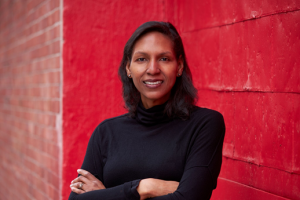
Courtney J. Martin, photo by Argenis Apolinario
As I have indicated, the field of British art–and of art history more generally—is developing and changing in such important ways, and I have no doubt that Courtney J. Martin, who just has begun her first term as the Center’s brilliant new director, will work with her YCBA colleagues not only to continue to introduce the work of new artists to the collection, but to encourage an ever-expanding community of visitors from the university, the city, the region, and the world through innovative displays, exhibitions, publications, and programs. She is a tremendous addition to the impressive complement of collection directors under the excellent leadership of Yale’s Vice Provost for Collections and Scholarly Communications, Susan Gibbons, and I expect that splendid developments are about to take place across all of the university’s museums and libraries with this gifted team in place.
JTP: What are you most proud of having accomplished at YBCA?
AM: My pride lies in what I was able to accomplish in concert with my superlative friends and colleagues: the staff of the YCBA and PMC, Yale students and faculty members, the 250 visiting scholars who have joined our community to pursue research in the YCBA’s collections, our advisory committees and consultants, the PMC’s Board of Governors, and supporters of both institutions. So much has been accomplished collectively that a full review would be impossible, but I will outline some of our most significant collaborative achievements.
Working with museums and cultural institutions across the UK, and in certain instances the United States, we developed a program of over fifty major loan exhibitions which explored a wide range of topics from the early modern period through the current day. These were underpinned by workshops involving students and scholars from around the world, and they were enhanced by an equivalent number of significant publications produced in association with Yale University Press London (YUPL). Approximately forty in-house exhibitions and displays, often developed with undergraduates and graduate students, enriched the exhibition program, examining the Center’s own holdings from important new vantage points.
One such exhibition, Unto This Last: Two Hundred Years of John Ruskin, curated by three of Tim Barringer’s graduate students—Tara Contractor, Victoria Hepburn, and Judith Stapleton—has been in the planning stages for some time as the Center’s central contribution to the bicentennial commemoration of Ruskin’s birth (both critical and celebratory), and it will open on the evening of September 17th of this year, accompanied by a leading-edge catalogue edited by Tim, to which the students, and others, have contributed. I have no doubt that for this cohort of students, the experience of working with Tim on an assessment of Ruskin’s significance as a thinker for the modern world will be as important as George Hersey’s Ruskin seminar was for me and my own group of peers over forty years ago.
During the last seventeen years, the research cultures of the YCBA and the PMC were augmented through the joint efforts of a new Research Division at the Yale Center and an amplified program at the London Centre, which also produced a superb run of publications with YUPL. Support of scholars across the field of British art was substantially increased through the PMC’s grant program and the YCBA’s visiting scholars program. The PMC and YCBA also collaborated to develop an innovative online journal, British Art Studies, which is fully accessible, free of charge, to the world.
The YCBA’s education program developed magnificently, as well. Our docents toured 92,929 school-age students through the galleries, and an average of 88 Yale classes utilized the collections each year, with nearly 14,000 Yale students visiting the Study Room either with a class or to use collections on their own. The Center hosted 903 undergraduate student interns and workers, 76 graduate student research assistants, and 20 postdoctoral research associates who received doctorates from other universities. Empirically based programs focused on close looking in the galleries, designed to increase both the sensitivity and diagnostic skills of medical and nursing students (the first such programs in the world), continued to develop for Yale graduate student in other fields.
Additionally, creative learning programs for teenage girls on the autism spectrum were put into place, and a teaching relationship with Chapel Haven, a home for adults with cognitive disabilities, flourished. The Center actively joined the university’s mentorship program to engage undergraduates who have attended New Haven public schools, or approved charter schools, and who have been awarded New Haven Promise scholarships, in professional experiences over the summer months. We benefitted from the fine work of those who were participants in the program, and we were able to add several extremely talented young people to our permanent staff from the program.
The collections also developed in exciting ways over the years, with curators adding to the historic corpus with important works from the Tudor period through the mid-twentieth century, and with modern and contemporary works expanding the Center’s holdings into our own time.
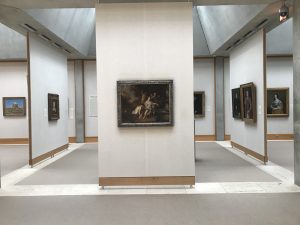
Fourth-floor gallery installation, including the new acquisition of Peter Lely’s Diana and her Nymphs at a Fountain (ca.1648), Yale Center for British Art, photo by Edward Town
Sculpture became a special focus of the acquisitions program, along with photography and modern and contemporary art. In all, almost 9,000 objects and collections across the curatorial departments amplified the Center’s holdings for teaching, research, and exhibition.
A program to make the Center’s entire collection accessible virtually, placed 90,000 records online, and 78,000 high-resolution digital images of works in the public domain freely available to the world for any use, in concert with Yale’s Open Access policy. The Center now seeks to connect these online collections with others across the university and the globe, through linked open data, allowing audiences worldwide to explore the rich global history of British art.
We also worked with collections across the university to develop a state-of-the-art conservation program on Yale’s West Campus, and to create the Institute for the Preservation of Cultural Heritage, with a major conservation science program intended not only for the technical assessment of our own collections, but also to address global conservation needs. Additionally, the Center published a model conservation plan for its landmark building designed by Louis I. Kahn, which has helped to steer the conservation of other modern buildings of cultural significance according to best practices. This plan allowed a three-phased conservation program to address the physical needs of the Kahn building, and following the conservation of the interior spaces and upgrading of the mechanical systems, a freshly conceived display of the art collections was installed, entitled “Britain in the World.”
JTP: What are you most excited about when you think of your next steps? Are there projects you are looking forward to?
AM: Returning to my own scholarship is a great joy, and I am beginning to work with Therese O’Malley to co-curate an exhibition examining the naturalists John and William Bartram and the early development of environmental thought in North America and the transatlantic world—a project that derives from the dissertations on which we worked together so many years ago, but that now is informed by the scholarship of those working on the culture of natural history in the Americas from new points of view.
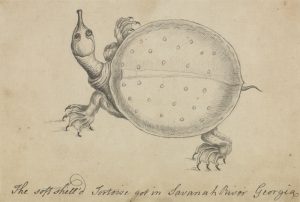
William Bartram, The Soft Shell’d Tortoise Got in Savanah River Georgia, ca. 1773, gray wash, pen and black ink, and graphite on paper, Yale Center for British Art, Gift of Charles Ryskamp
The Bartrams, who created one of the first scientific gardens in the British colonies, began to be mythologized in their own time, and have been the focus of academic study since the nineteenth century. However, their work is just beginning to be assessed in relation to the knowledge they gained not only from Native American peoples they encountered on their collecting expeditions, but from enslaved peoples of African descent in bondage to the Bartrams’ family members and friends throughout the southern colonies, as well as those William himself enslaved on a small, short-lived plantation that he attempted to establish in Florida. This project will serve as a case study examining the diverse systems of knowledge about nature that converged and collided in this period, resulting in new conceptions of a wholly interconnected cosmos, in a constant state of flux.
Amy Meyers BIOGRAPHY
Amy Meyers (Yale PhD, American Studies, 1985) retired from the directorship of the Yale Center for British Art on June 30th of this year. Prior to her appointment in July of 2002, she spent much of her career at research institutes, including Dumbarton Oaks; the Center for Advanced Study in Visual Arts at the National Gallery of Art, Washington, D.C; and The Huntington Library, Art Collections, and Botanical Gardens, where she served as Curator of American Art from 1988 through June of 2002. Meyers also has taught the history of art at the California Institute of Technology, the University of Michigan, Mount Vernon College, and Yale. As Director of the Center, Meyers sought to strengthen the institution’s educational and research initiatives. She endeavored to promote a rigorous academic publication program in association with Yale University Press and to develop an exhibition program of the highest scholarly standard in partnership with major museums across Europe and the United States. She expanded the Center’s fellowship program; amplified the teaching mission in concert with departments and programs across the university; and promoted the cataloguing of the collections on-line, with free and open access to all images in the public domain. Meyers supported the creation of a conservation plan for the institution’s landmark building, designed by Louis I. Kahn, and she oversaw the conservation of the building, as well as two full-scale reinstallations of the entire collection.
Meyers has written extensively on the visual and material culture of natural history in the transatlantic world, serving as editor of Knowing Nature: Art and Science in Philadelphia, 1740 to 1840, with the assistance of Lisa Ford (New Haven: Yale University Press, 2011); with Harold Cook and Pamela Smith, Ways of Making and Knowing: The Material Culture of Empirical Knowledge (Ann Arbor: The University of Michigan Press, 2011); with Therese O’Malley, The Art of Natural History: Illustrated Treatises and Botanical Paintings, 1400-1850 (Washington, D.C.: National Gallery of Art, Studies in The History of Art Series, 2008); Art and Science in America: Issues of Representation (San Marino: The Huntington, 1998); and, with Margaret Pritchard, Empire’s Nature: Mark Catesby’s New World Vision (Chapel Hill: University of North Carolina Press, 1998). She also has organized numerous international symposia in the field, including Curious Specimens: Enlightenment Objects, Collections, Narratives (with Luisa Calè, Michael Snodin, Margaret Powell, and Cynthia Roman; London, 2010), Ways of Making and Knowing: The Material Culture of Empirical Knowledge (with Hal Cook and Pamela Smith; London, 2005); and ‘Curious in Our Way’: The Culture of Nature in Philadelphia, 1740 to 1840 (Philadelphia, 2004). With Therese O’Malley, she currently is co-organizing an exhibition on John and William Bartram and the emergence of an environmental conception of the natural world in colonial and early republican America, to be mounted in 2024.



